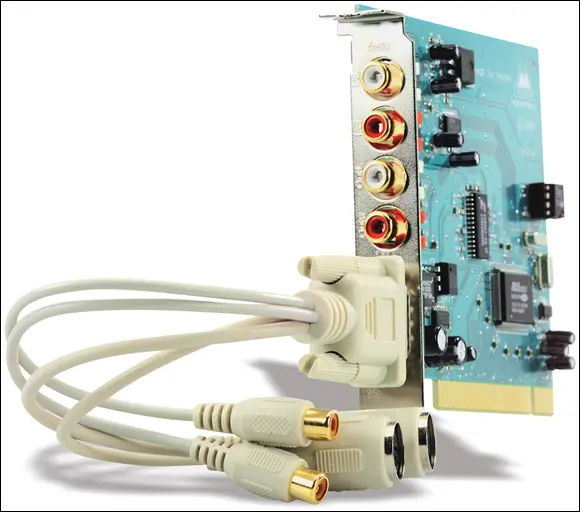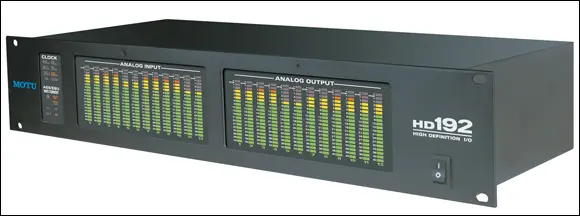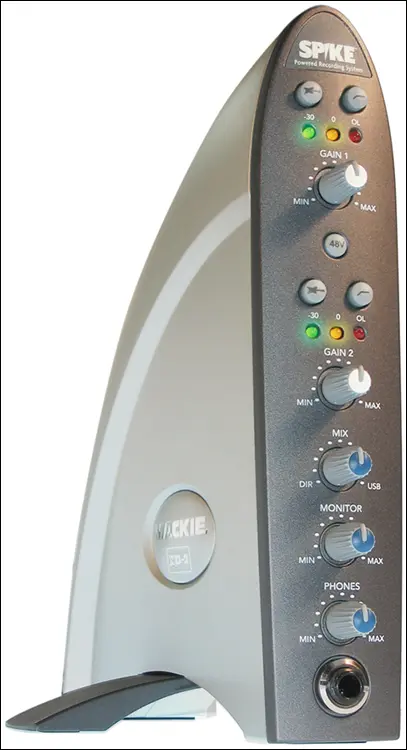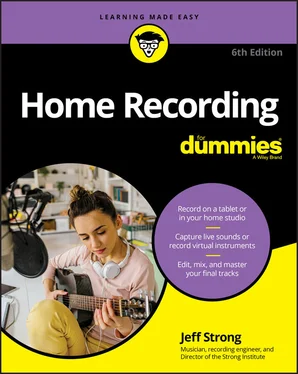1 ...8 9 10 12 13 14 ...20 Analog inputs and outputs housed in a separate box: This box is called a breakout box. Because of the low-level hum problems in the early interfaces, most manufacturers of PCIe-based audio interfaces put their analog circuitry in a separate box with a cord attached to the PCIe card. One advantage to this — besides eliminating the hum in early models — is that you can tweak the input and output levels without having to use a software menu. The dials for the levels are placed on the breakout box within easy reach, as shown in Figure 2-3.
 If your preferred audio recording computer doesn’t have a PCIe slot, don’t worry (or don’t bother adding one). Thunderbolt and USB are both excellent technologies to use for recording music.
If your preferred audio recording computer doesn’t have a PCIe slot, don’t worry (or don’t bother adding one). Thunderbolt and USB are both excellent technologies to use for recording music.

FIGURE 2-2:Some PCIe interfaces often come with analog connectors run from the computer.

FIGURE 2-3:A PCIe interface with a breakout box for the analog components is the preferred form of PCIe interface.
USB interfaces (see Figure 2-4) come in two varieties: those using USB 2.0, and those using USB 3.0. Most computers have at least one USB port. USB is a great option for your audio interface. They can be inexpensive and offer a variety of input/output configurations.
 Beware of used USB 1.1 interfaces. The latency (delay between the sound entering the interface and exiting your speakers) is too great to keep from being frustrating. You can find decent USB 2.0 and USB 3.0 interfaces for very little money, often starting at about $100 (USB 2.0), though they can run as much as $1,000 (USB 3.0), depending on the manufacturer and the number of tracks and other options they include.
Beware of used USB 1.1 interfaces. The latency (delay between the sound entering the interface and exiting your speakers) is too great to keep from being frustrating. You can find decent USB 2.0 and USB 3.0 interfaces for very little money, often starting at about $100 (USB 2.0), though they can run as much as $1,000 (USB 3.0), depending on the manufacturer and the number of tracks and other options they include.

FIGURE 2-4:A USB interface connects to your computer’s USB port.
For the last two revisions of this book, I had hoped that I could talk at length about the super, most awesome Thunderbolt interface and how it changed recording in the same way that moving from tape to digital did, but, alas, I wasn’t able to. However, now I can. Though it would be a stretch to say that Thunderbolt has reinvented audio recording, it does offer some benefits that makes it better than either PCIe or USB.
Compared to USB, Thunderbolt offers eight times faster transfer speed and the ability to chain a variety of devices through the same port without any loss of speed. This means you can have more analog inputs and outputs than USB.
Compared to PCIe, Thunderbolt connectivity is more available — you can find them on laptops as well as on desktop computers. There are also many more interface options to choose from.
Thunderbolt audio interfaces tend to be more expensive than USB, not because of the technology, but because these interfaces often include better analog components, such as preamps, and more inputs and outputs. Expect to spend at least $500 for two input channels and $1,000 and more (often much more) for higher counts.
 Quite a few audio interfaces have both Thunderbolt and USB 3.0 ports. If you’re unsure of which to choose, or you plan to upgrade your computer from USB to Thunderbolt, these interfaces are excellent options.
Quite a few audio interfaces have both Thunderbolt and USB 3.0 ports. If you’re unsure of which to choose, or you plan to upgrade your computer from USB to Thunderbolt, these interfaces are excellent options.
Choosing the right software
 When setting up a recording system, I always recommend that you start by exploring the software you want to use. Whatever program you decide to use will work better on one type of computer than another. By choosing the software first, you can use the software manufacturer’s guidelines to help you set up your computer. Most software is written for either a Mac or a PC and has been tested with a variety of hardware configurations. Unless you’re very computer savvy, I recommend starting with a system that’s been tested to run smoothly with the program that interests you.
When setting up a recording system, I always recommend that you start by exploring the software you want to use. Whatever program you decide to use will work better on one type of computer than another. By choosing the software first, you can use the software manufacturer’s guidelines to help you set up your computer. Most software is written for either a Mac or a PC and has been tested with a variety of hardware configurations. Unless you’re very computer savvy, I recommend starting with a system that’s been tested to run smoothly with the program that interests you.
For the most part, audio production software falls into the following two categories:
Audio-recording programs: These programs allow you to record numerous tracks (the number depends on the program) and let you edit, equalize, and mix those tracks as well as add effects.
MIDI-sequencing programs: These programs allow you to record MIDI performance data (without the sounds) and edit and mix the data. The difference between audio and MIDI recording is covered in detail in Chapter 11.
 Most audio production programs offer both audio and MIDI recording and generally do a good job of both (and they’re getting better all the time), but some entry-level programs allow you to only record audio or do MIDI sequencing. If your budget is limited and you want to record using both audio and MIDI, make sure that your chosen software allows you to do so. That said, choose the program based on its features and whether it fits with your working style.
Most audio production programs offer both audio and MIDI recording and generally do a good job of both (and they’re getting better all the time), but some entry-level programs allow you to only record audio or do MIDI sequencing. If your budget is limited and you want to record using both audio and MIDI, make sure that your chosen software allows you to do so. That said, choose the program based on its features and whether it fits with your working style.
Researching a program you’re interested in
If you already own a computer and you want audio-recording or sequencing software to go with it, do the following research on the software that interests you:
Find out the product’s compatibility with your system. Visit the software manufacturer’s website for information about whether your system will work with that program, as well as what additional hardware you may need in order to get the software up and running.
Find out what other users are saying. On the Internet, you can find an online discussion board for each of the major audio-recording software programs. Before you buy a program, go to the sites of the programs that interest you and see what people are saying about them. Ask questions and explore the issues that other people are having with the programs. Doing so can save you lots of time dealing with bugs in your system and allow you to record a lot more music. You can find these sites by using the product name as the keyword in your favorite search engine and checking out the Internet forums. One great way to see whether a particular program is right for you is to find out what people who play your type of music are using. For instance, a lot of people who compose with synthesizers and MIDI use Logic Pro X because using MIDI and software synthesizers is quick and easy in this program. They also don’t need a bunch of hardware synthesizers to get the sounds they want, which saves space in their studio and saves money, because they can bypass the hardware to get their synthesizer sounds.
Checking out some popular programs
Читать дальше

 If your preferred audio recording computer doesn’t have a PCIe slot, don’t worry (or don’t bother adding one). Thunderbolt and USB are both excellent technologies to use for recording music.
If your preferred audio recording computer doesn’t have a PCIe slot, don’t worry (or don’t bother adding one). Thunderbolt and USB are both excellent technologies to use for recording music.

 Beware of used USB 1.1 interfaces. The latency (delay between the sound entering the interface and exiting your speakers) is too great to keep from being frustrating. You can find decent USB 2.0 and USB 3.0 interfaces for very little money, often starting at about $100 (USB 2.0), though they can run as much as $1,000 (USB 3.0), depending on the manufacturer and the number of tracks and other options they include.
Beware of used USB 1.1 interfaces. The latency (delay between the sound entering the interface and exiting your speakers) is too great to keep from being frustrating. You can find decent USB 2.0 and USB 3.0 interfaces for very little money, often starting at about $100 (USB 2.0), though they can run as much as $1,000 (USB 3.0), depending on the manufacturer and the number of tracks and other options they include.
 Most audio production programs offer both audio and MIDI recording and generally do a good job of both (and they’re getting better all the time), but some entry-level programs allow you to only record audio or do MIDI sequencing. If your budget is limited and you want to record using both audio and MIDI, make sure that your chosen software allows you to do so. That said, choose the program based on its features and whether it fits with your working style.
Most audio production programs offer both audio and MIDI recording and generally do a good job of both (and they’re getting better all the time), but some entry-level programs allow you to only record audio or do MIDI sequencing. If your budget is limited and you want to record using both audio and MIDI, make sure that your chosen software allows you to do so. That said, choose the program based on its features and whether it fits with your working style.










